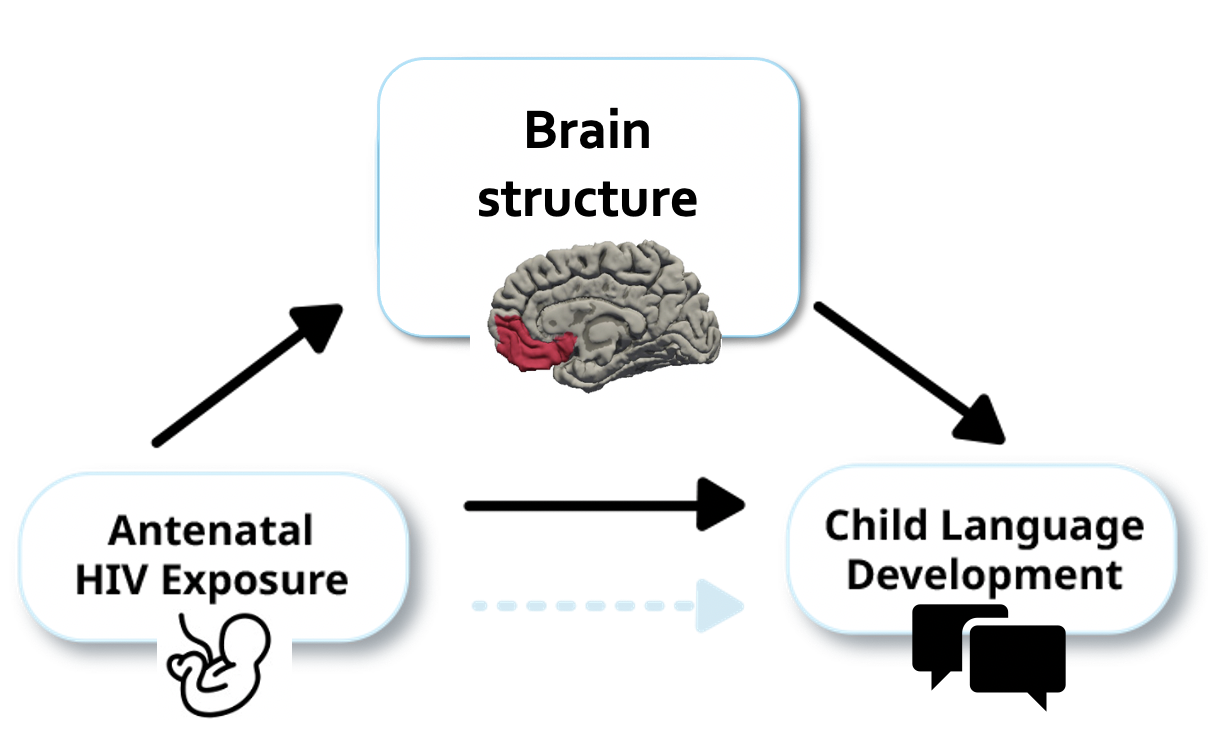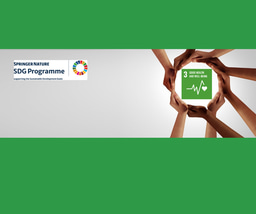Association of in utero HIV exposure with child brain structure and language development: a South African birth cohort study
Published in General & Internal Medicine, Public Health, and Behavioural Sciences & Psychology

Introduction
Over 1 million children are born to mothers living with HIV every year, and in some countries, more than 1 in 5 children have HIV exposure. Thanks to antiretroviral medications there have been huge successes in preventing transmission of HIV, meaning that most of these children will remain HIV-free. However, although these children do not get HIV infection, being exposed to HIV in pregnancy may still increase the risk of poorer health, growth, and developmental outcomes. Evidence suggests more children with HIV exposure have delays in early language and motor function than children without HIV exposure. Brain development underpins cognitive function and advances in neuroimaging now allow us to study how HIV exposure may impact brain development. This research provides new insights into the potential effects of HIV exposure on child brain and language development.
What inspired this study and why is it important?
Early neurodevelopment is critical to later health and societal outcomes. Worldwide, over 250 million children under five are at-risk of not reaching their developmental potential, with the highest numbers in sub-Saharan Africa. The reasons for this are varied, and include factors like infectious diseases. Given many children in this region are exposed to HIV in pregnancy, it is crucial that we study how HIV exposure affects child brain development. Understanding the effects of HIV exposure on the brain may help guide interventions that ensure children not only remain HIV-free, but also thrive, reaching their full developmental potential.
What makes this study unique?
Neuroimaging of young children is extremely challenging because it requires them to stay still for long periods of time to capture high quality clear images. Across Africa there are also very few magnetic resonance imaging (MRI) scanners and access to imaging is therefore limited. This is the first study to examine the components of cortical brain structure in children with HIV exposure in pregnancy.
What did this study do?
The Drakenstein Child Health Study is a population-based birth cohort in the Western Cape of South Africa. In this study, we conducted MRI in natural sleep in children with HIV exposure and compared their brain structure to those without HIV exposure, and how it corresponded to language development outcomes.
What did the study show?
Children who were exposed to HIV in pregnancy showed differences in brain structure compared to children not exposed to HIV. Specifically, their brain cortex, particularly in the medial orbitofrontal region, was on average thicker than in children without HIV exposure. Secondly, children with HIV exposure had lower mean language scores compared to HIV-unexposed children, and the brain differences were linked to the lower language scores, Overall, the study found that differences in cortical brain structure in specific brain regions may partly explain the connection between HIV exposure and poor language outcomes.

The main takeaway from this study is that HIV exposure in utero may impact early brain development and language function for some children. With over 16 million children worldwide who are HIV-exposed and uninfected, these findings may inform monitoring and intervention strategies to improve outcomes. Another recent study has shown that better maternal HIV care improves the child brain outcomes, which suggests ways to optimise neurodevelopment in the future. Finally, the study also highlights how brain development relates to language skills in all children.
References:
Gilmore JH, Knickmeyer RC, Gao W. Imaging structural and functional brain development in early childhood. Nat Rev Neurosci. 2018;19(3):123–37. DOI: 10.1038/nrn.2018.1
UNAIDS. AIDSinfo. Available from: http://aidsinfo.unaids.org
Wedderburn CJ, Subramoney S, Yeung S, Fouche JP, Joshi SH, Narr KL, et al. Neuroimaging young children and associations with neurocognitive development in a South African birth cohort study. Neuroimage. 2020;219:116846. DOI: 10.1016/j.neuroimage.2020.116846
Wedderburn CJ, Weldon E, Bertran-Cobo C, Rehman AM, Stein DJ, Gibb DM, et al. Early neurodevelopment of HIV-exposed uninfected children in the era of antiretroviral therapy: a systematic review and meta-analysis. Lancet Child Adolesc Health. 2022;6(6):393–408. DOI: 10.1016/S2352-4642(22)00071-2
Zar HJ, Barnett W, Myer L, Stein DJ, Nicol MP. Investigating the early-life determinants of illness in Africa: the Drakenstein Child Health Study. Thorax. 2015;70(6):592-4. DOI: 10.1136/thoraxjnl-2014-206242
Follow the Topic
-
BMC Medicine

This journal publishes outstanding and influential research in all areas of clinical practice, translational medicine, medical and health advances, public health, global health, policy, and general topics of interest to the biomedical and sociomedical professional communities.
Related Collections
With Collections, you can get published faster and increase your visibility.
Healthy aging and longevity: the role of preventive medicine and risk factors
BMC Medicine is calling for submissions to our Collection on healthy aging and longevity, emphasizing the interplay between physical, cognitive, and social functioning that enables an average lifespan under ideal conditions. As populations age globally, the research focus has shifted from increasing lifespan to enhancing “healthspan”—the period of life spent in good health. This Collection seeks to explore innovative approaches and cutting-edge research in areas such as healthy aging, preventative medicine, and the role of risk factors in promoting longevity. With a focus on mitigating modifiable risk factors with dietary and lifestyle interventions or personalized care, and on tackling genetic predisposition with a proactive, preventive approach, this Collection will aim to expand our knowledge of key determinants of the quality of life for older adults.
Recent findings highlight the complexity of the relationships between genetics, lifestyle choices, and environmental factors from early life to later influencing health outcomes. By addressing these complex interactions with interventions targeting nutrition, physical activity, risk stratification, and treatment for chronic diseases throughout the lifespan, we can create effective strategies to enhance the quality of life as people age and mitigating the effects of multimorbidity and frailty among older adults.
A preventive, life course approach to health and longevity research is highly relevant to public health as it addresses the root causes of diseases and promotes overall well-being from early life through old age. By focusing on prevention and early intervention, it aims to reduce the incidence of chronic diseases, improve quality of life, and extend healthy life expectancy. Moreover, investing in preventive measures such as healthy lifestyle promotion, early screenings, and immunizations reduces healthcare costs in the long term by reducing the need for expensive treatments and hospitalizations.
Health inequities in aging women's care pose an additional challenge to the public health management of aging, as women often face inequities influenced by a combination of biological, social, and economic factors. Gender biases in healthcare practice and medical research often result in women receiving less effective treatments and having their symptoms dismissed or underestimated. Women of color and those from lower-income households are particularly vulnerable to these disparities. Addressing these inequities requires a multifaceted approach, including improving access to preventative healthcare and addressing social determinants of health.
Continued research in health and longevity may pave the way for transformative breakthroughs in public health policies, aging-related therapies and innovative interventions. As our understanding deepens, we must develop more personalized approaches to health management, improve the resilience of aging populations, and ultimately reshape how we view aging in society.
Topics of interest include but are not limited to:
-Healthy aging and lifestyle interventions
-Preventative medicine and early intervention approaches
-Multidisciplinary approaches to longevity
-Nutrition and physical activity in healthspan
-Modifiable risk factors and risk stratification for cardiovascular and neurological disease in older adults
-Women’s health aging, including research on menopause and ovarian function
All manuscripts submitted to this journal, including those submitted to collections and special issues, are assessed in line with our editorial policies and the journal’s peer review process. Reviewers and editors are required to declare competing interests and can be excluded from the peer review process if a competing interest exists.
This Collection supports and amplifies research related to SDG 3 (Good Health and Well-being).
Publishing Model: Open Access
Deadline: Jan 29, 2026
Climate change and human health
BMC Medicine is calling for submissions to our new Collection on the health impacts of climate change. The relationship between global warming and human health is increasingly becoming a focal point in public health research. Rising temperatures, shifting weather patterns, and extreme weather events are projected to have profound effects on various health outcomes. From increased prevalence of vector-borne diseases to heightened risks of heat-related illnesses, the health implications of climate change are vast and multifaceted. This Collection aims to explore the direct and indirect impacts of global warming on health, examining how these changes affect vulnerable populations and health systems worldwide.
Understanding the implications of global warming for human health is crucial for developing effective public health strategies and interventions. Recent research has highlighted the links between climate change and a variety of health issues, including air pollution, water-borne diseases, and undernutrition. Advances in climate modeling and epidemiological studies have enhanced our ability to predict health outcomes related to climate change, providing invaluable insights that can inform policy decisions and health care planning.
Continued research in this area may lead to innovative solutions to mitigate the health impacts of climate change. For example, interdisciplinary approaches that integrate climate science, public health, and social determinants of health could reveal new pathways for adaptation and resilience. Future studies may also focus on the development of health infrastructure designed to withstand climate-related stresses, thus improving community health outcomes in an era of global warming.
We are considering manuscripts on, but not limited to the following topics:
-Impact of air pollution on health
-Heat-related illnesses
-Water-, and vector-borne diseases in a warming world
-Social determinants of health and climate vulnerability
-How health systems and infrastructure may be affected by climate change
-Nutrition and health in the context of climate change
-Impacts of climate change on non-communicable diseases
All manuscripts submitted to this journal, including those submitted to collections and special issues, are assessed in line with our editorial policies and the journal’s peer review process. Reviewers and editors are required to declare competing interests and can be excluded from the peer review process if a competing interest exists.
This Collection supports and amplifies research related to SDG 3 (Good Health and Well-being) and SDG 13 (Climate Action).
Publishing Model: Open Access
Deadline: Mar 02, 2026






Please sign in or register for FREE
If you are a registered user on Research Communities by Springer Nature, please sign in